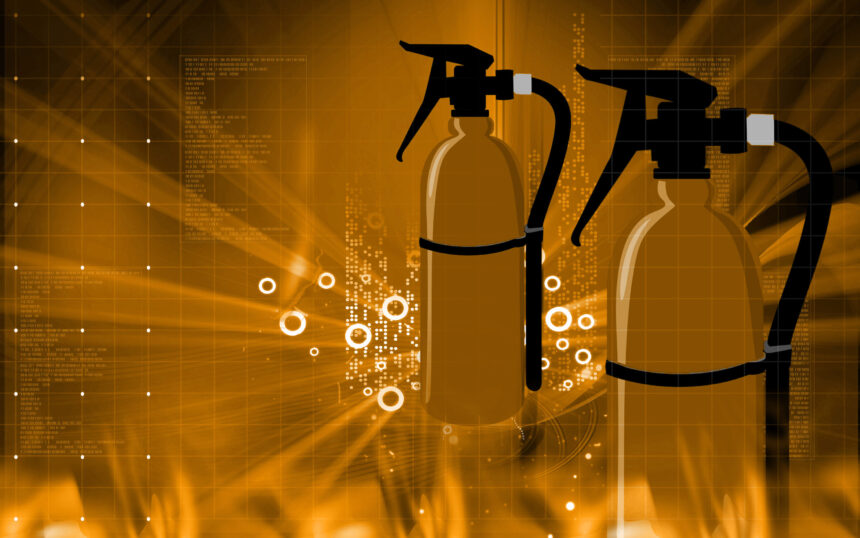When a fire breaks out in a building, it should be contained as quickly as possible. Portable fire extinguishers are a first-response tool that can help to prevent catastrophic property damage. However, when it comes to mission-critical operations such as data centers, hospital laboratories, or sterile manufacturing units, fire damage isn’t the only concern.
Fire extinguishers are designed to tackle smaller fires fast, keeping the harm caused by fire to a minimum. However, some extinguishers are filled with chemical agents that can leave residues that cause additional damage to facilities and the high-value equipment and materials within them. This can cause extensive damage and disruption and can lead to high costs to repair or replace items damaged from exposure to the chemical agents – even if the fire was small and contained quickly.
Ensuring Operational Continuity and Reducing Costs
Electrical damage, melting of materials, corrosion, and contamination of ventilation systems are examples of the impact some fire extinguisher agents can have. There are many potential repercussions of damage caused by a fire or by the extinguishers used to put it out. The facility’s operations could be stopped until new equipment is found and affected areas are made fit to use again. And with such facilities as libraries or museums, the damaged items may be irreplaceable.
The financial impact of a facility closure after a fire event can be significant to owners, workers, and customers. This is especially true if there are no alternative facilities from which to continue operating and services for customers are unavailable. Should facilities face lengthy repair or cleanup operations following a fire, the facility owners will bear the cost of delay in terms of money, time, and productivity.
Such factors as the possibility of relocating to an alternative facility need to be considered too, though moving people and operations to a new facility will still impact productivity. If relocation isn’t possible, owners may have to furlough employees while operations are on hold. In the case of medical and other care environments, they may have to move patients to other facilities.
A fire event is something no organization or facility wants to deal with. However, if one occurs, it’s to an organization’s benefit to contain it with portable fire extinguishers that allow for quick and straightforward cleanup, helping to minimize disruption to the facility’s operations and reduce the financial impact on everyone involved.
Extinguishers containing gaseous agents such as FK-5-1-12 help to minimize disruption and reduce the need for costly ‘Plan B’ contingencies as there’s no need to clean up after use.
Fire Safety and Sustainability
In addition to keeping people and equipment safe and business operations running smoothly, many facility owners and managers need to meet sustainability initiatives. Achieving net zero carbon emissions in the coming years is a big priority for many organizations.
The type of fire safety devices – including the extinguishers used by an organization – plays an important part in building safety, as well as a significant role in a facility’s sustainability credentials. For example, the hydrofluorocarbons used within some extinguishers can have a negative impact on a facility’s greenhouse gas footprint. Upgrading to portable fire extinguishers that do not use these chemicals to tackle fire events is another reason to consider the extinguishers used within the facility.
The FK-5-1-12 agent helps to successfully put out fires without causing extensive damage to facilities or materials. Importantly, this new agent has a global warming potential (GWP) of 0.01 and an ozone depletion potential (ODP) of 0.00, helping organizations meet their sustainability goals. It also has an atmospheric life span rating of less than seven days, is compliant with the NFPA 10 Standard for Portable Fire Extinguishers, and is UL-ULC Listed.
An Efficient, Safer, and Compliant Alternative
New, clean agent extinguisher technology meets the need for effective first-response firefighting while not damaging the sensitive materials and equipment within the building. For example, if a containable fire event occurs in a data center or laboratory, the use of these new fire extinguishment solutions could facilitate quickly getting a business back up and running while minimizing disruption and downtime.
Clean agent extinguishers provide essential fire extinguishing efficiency for mission-critical facilities that have sensitive equipment or irreplaceable assets. This includes such facilities as those that handle pharmaceutical production, clean manufacturing, and healthcare. Even valuable artifacts can benefit from this safer and cleaner protection. And if the extinguishers are discharged, they will not contribute to a lengthy cleanup, reducing the disruption to operations – and the costs associated with closing down or stopping activities after a fire event.
The new technology used in the FK-5-1-12 solution is compliant with the American Innovation and Manufacturing (AIM) Act and is also not expected to be phased out under the Montreal Protocol. Other extinguishers that use more harmful agents are already being phased out due to their not meeting compliance requirements and are beginning to show higher costs.
Extinguish the Fire, Not Your Business
The importance of keeping people safe if they are in a fire event where they need to use a fire extinguisher is critical. Tested by the Cardiotox LOAEL and Cardiotox NOAEL Acute Toxicity rankings reveals that exposure to FK-5-1-12, as used CLEANGUARD+, is less toxic than other, typical clean agents, so it’s safer to discharge in much smaller spaces. This means personnel using these fire extinguishers are less exposed to harmful chemicals than they would be using alternative extinguishers.
All buildings – especially mission-critical facilities – should regularly assess their current fire extinguishers and consider whether more effective possibilities are available, particularly when a hard shutdown is out of the question for business continuity.
Danielle Felch is product manager for portable fire suppression products at Johnson Controls.




